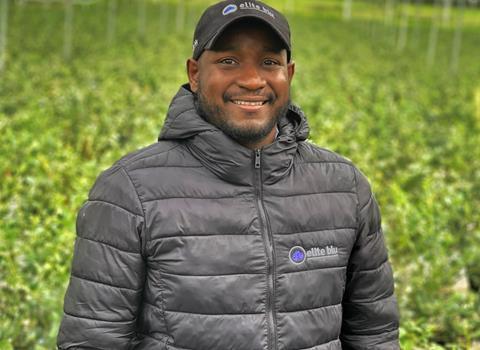Colombia has the potential to become a key player in the global blueberry market

As an agronomist with 19 years of experience in Colombia’s vibrant agricultural sector, I have been involved in the development of many agro-industries and the generation of equity in rural areas, always focused on sustainable production.
However, my approach has evolved to understand that actions in the rural sector also have a profound impact on reducing poverty and improving economic conditions, which translates into equity for my compatriots and for the development of the country.
Twenty-four per cent of Colombia’s population lives in rural areas and more than 3.5m people work directly in agriculture. So the challenge is to identify crops that create jobs and improve rural life indicators. Currently I cannot think of a crop that satisfies these intentions better than blueberries. The technical package that we have developed allows us to provide decent employment to more than six people per hectare of permanent cultivation. If we consider that in our country blueberries can be grown through 52 weeks of the year, this allows us to supply all the market windows during the year.
Colombia’s blueberry history began approximately 25 years ago, when the first planting materials arrived in the country. The first attempts to cultivate the berry centred on the Biloxi variety, but the process was not yet technical. The great blue dream remained dormant for more than 15 years, until in 2017, more structured planting projects began to spring up in the departments of Cundinamarca and Boyacá, ideal regions for the production of fruit trees due to their ready availability of water and concentration of labour.
Today those regions host the largest area planted with blueberries in the country. We have gone through a steep learning curve that has required us to overcome many challenges, but we are now at a point where we can affirm that the blue dream in Colombia has truly begun.
In my role as manager of the most important blueberry production company in Colombia, I have consolidated the export operations of this fruit and adapted the crop management plan to the conditions of the high tropics, allowing us to produce for 52 weeks of the year. (I know that for many readers it is complex to understand, but in my country we are in eternal spring, while also having the necessary cold hours to send the message to the plants to bloom permanently).
At the end of 2022, Colombia’s blueberry cultivated area stood at 600ha. We are still in the process of updating the information for 2023, but what we do know is that 2024 will be a year of expansion.
Among the varieties that have shown the best performance are Biloxi, Ventura, Victoria, and Emerald. We have also started projects to introduce premium materials from all the Breeders present in Latin America.
Planting densities vary from 5,500 to 9,000 plants per hectare, depending on the variety. The average Brix we achieve at harvest is 13.4o, which gives our blueberries their distinctive sweetness and flavour. This sweetness allows us to organoleptically enhance the development of the berry and establish market niches that value the balance between acidity and sweetness.
Productivity per hectare has the potential to exceed 30 tonnes, thanks to a production model focused on the management of the same plant during 52 weeks of the year. With programmed pruning, we have established a method called “evergreen” that achieves a balance of all the physiological phases of the crop, allowing a plant to deliver fruit every eight days throughout the year.
Current performance on promising materials like Emerald, under our conditions, has shown impressive production potential. We are achieving a productivity of 2.2kg in the first year of production, 4.26kg in the second year, forecasts of up to 5.8kg in the third year and stabilising with values higher than 6.5kg per year starting in the fourth year. These results are indicative of the potential that Colombia has to become a key player in the global blueberry market.
Moreover, Colombia’s strategic geographic location offers a unique advantage: facilitating faster access to international markets. This is particularly relevant for exports to the US, which is currently our main trading partner in the fruit sector. However, it is crucial to also recognise the growing opportunities in Canada, a significant emerging market for our products.
Regarding the conquest of that market, in the first days of 2024 we made our first test shipment of blueberries to Canada. Establishing the protocol for exporting to that country was a key achievement of 2023. This advance not only marks significant growth in the development of the sector, but also opens doors to new consumers. I am confident that the Colombian blueberry, recognised for its unique attributes and its transformative socioeconomic impact on Colombian rural areas, will become the favourite of our current and future customers.
It is clear that we are now living a blue dream, a huge opportunity to promote the development of blueberry cultivation in Colombia under the premise of differentiation by flavour. We have the land, the people and the water that allow us to dream of exponentially increasing our planted areas and thereby giving rural people the opportunity to have decent and stable jobs.
I invite you to join Colombia’s blue dream, to help us develop and provide opportunities to a country with a high agricultural vocation and a high development potential. This will allow our agricultural production to shine and will confirm the impact that development generates on the reduction of poverty and increase of equity in a country where these are essential.
Miller Preciado is operations manager of Elite Blu, Colombia’s largest blueberry exporter.



